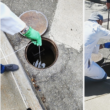Managing biorisks: The need for international solutions
By Jonathan B. Tucker, May 29, 2008
It's clear from this roundtable discussion that recent advances in biotechnology are outstripping the legal and normative bulwarks designed to prevent the misuse of the life sciences for hostile purposes. The challenge of managing biorisks is complicated by the fact that the relevant technologies are diffusing globally and are driven primarily by innovation in the private sector. For example, dozens of mail-order companies called "biofabs," which synthesize customized pieces of DNA for scientific and corporate clients, have emerged in locations around the world, such as China, India, Iran, Russia, and South Korea. (Examples of biofabs include Blue Heron Biotechnology in Bothel, Washington, Codon Devices in Cambridge, Massachussetts, Bioneer in Daejeon, South Korea, CinnaGen in Tehran, Evrogen in Moscow, and Tech Dragon in Hong Kong.) Yet no international regulatory structures are in place to ensure that proliferators and terrorists do not use these firms to acquire pathogenic genes and lethal viruses.
One problem is that governments lack the political will to address the risks associated with emerging biotechnologies in a concerted manner. Not only has renewed concern over nuclear weapons proliferation overshadowed biological and chemical threats in the eyes of policy makers, but they also tend to believe that the dual-use challenges posed by biotechnology fall into the "too-hard" category.
At the international level, the lack of an institutional framework has hampered efforts to manage biorisks. Ever since the collapse in 2001 of negotiations to develop an inspection protocol for the Biological and Toxin Weapons Convention (BWC), which would have established a new international organization to oversee the treaty's implementation, efforts to prevent the misuse of biotechnology for weapons purposes have proceeded on an ad hoc basis. BWC member states have agreed to gather each year until the next review conference in 2011 to discuss various topics related to the treaty, but these meetings are confined to exchanges of information, with no decision-making. Moreover, in contrast to the International Atomic Energy Agency in Vienna and the Organization for the Prohibition of Chemical Weapons (OPCW) in The Hague, no international organization has the mandate to bolster the norm against the hostile uses of biology, establish and enforce minimum global standards for the safe and secure handling of dangerous pathogens and the oversight of dual-use research, and assist developing countries to build capacity in these areas.
Seeking to fill this institutional deficit, a number of international bodies have launched initiatives in the biosecurity field, including the World Health Organization, the Organization for Economic Cooperation and Development, and the International Criminal Police Organization (Interpol), as well as nongovernmental organizations such as the International Committee of the Red Cross and the Verification Research, Training and Information Centre. These efforts, while individually useful, remain scattered and poorly coordinated.
Another proposed approach to remedy the deficits in the biological disarmament regime is to draw on the verification mechanisms of the Chemical Weapons Convention (CWC) where they overlap with the BWC, namely with respect to non-living toxic chemicals produced by living organisms (toxins and bioregulators). Yet little progress has been made on this track. Although the OPCW has a Scientific Advisory Board that monitors scientific and technological developments with implications for the CWC, the board lacks credibility and political weight, and none of its recommendations has been approved by member states. Moreover, the Second Review Conference of the CWC this past April was characterized by disruptive North-South tensions that blocked consensus on major steps to adapt the CWC verification regime to the changing nature of the global chemical industry and the growing convergence of chemistry and biology, as Ralf Trapp noted earlier. The international community appears deadlocked about how to manage the dual-use risks associated with the galloping advances in biological science and technology.
One new initiative offers a possible way forward. In November 2006, shortly before completing his second term, U.N. Secretary-General Kofi Annan gave a speech at the University of St. Gallen in Switzerland in which he warned that as advanced biotechnologies become increasingly available, their safety and security risks will increase exponentially. "When used negligently, or misused deliberately, biotechnology could inflict the most profound human suffering–ranging from the accidental release of disease agents into the environment to intentional disease outbreaks caused by state or non-state actors," he said. To address this danger, Annan proposed that the United Nations coordinate a global forum to discuss how to make the benefits of biotechnology available to all, while managing and mitigating its potentially catastrophic risks. The forum would not be a new U.N. organization but rather a series of high-level meetings involving world leaders from government, industry, science, public health, and law enforcement.
Annan's successor Ban Ki-Moon did not assign a high priority to the St. Gallen initiative, which has since received little public mention. Nevertheless, a small group of champions has met quietly during the past 18 months to flesh out the proposal, which is likely to be unveiled in the fall. The U.N. global forum on biotechnology should play a valuable role by helping to educate government policy makers and the general public. Even so, it will not fill the institutional deficit at the heart of the biological disarmament regime. Managing the dual-use risks associated with biotechnology requires coordinated global action that only an international organization can muster. There is simply no way that the United States can tackle this thorny problem on its own.
Topics: Biosecurity
Share: [addthis tool="addthis_inline_share_toolbox"]














